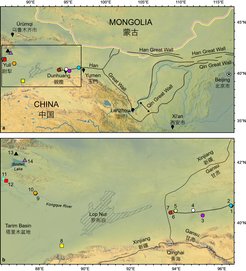Reeds from Great Wall Reveal Climate of Ancient Northwestern China
Plant remains used in some of the earliest Great Wall segments show climatic and environmental changes across northwestern China since the Han Dynasty

at Majuanwan; (c) Remnants of
Sishilidadun Beacon Tower (Site 14) dating to the Song Dynasty; (d) Low altitude air photo of the Yakelun Beacon Tower (Site 11), courtesy of Xingjun Hu. Note the wild plants growing adjacent
to the tower.
Monuments serve as messages to future societies, revealing historical and cultural information about the society that created them. Widely considered the largest cultural monument in the world, the Great Wall of China reveals much about the political, social, and technical states of Chinese dynasties. Now, investigation of some of the oldest sections of the Great Wall is bringing new information to light, offering insights on the sourcing of organic building materials and local climatic and environmental conditions some 2,000 years ago.
A recent paper in Scientific Reports by an international team of researchers reports that the climate of northwestern China has changed drastically in the millennia since the Han dynasty, with the most severe changes occurring the last 70 years. Stable carbon isotope values retrieved from the ancient building materials suggest that the now arid Tarim Basin region was once scattered with oases where common reeds (Phragmites) were harvested and used for wall construction. The publication is the first attempt to use organic materials from the Great Wall to identify their source and the climatic information they contain.

of the Yingpan City Heritage Site; (11) Yakelun Beacon Tower; (12) Sunji Beacon Tower; (13) Tahaqi Beacon Tower; (14) Sishilidadun Beacon Tower. Circles date to the Han Dynasty, hexagons to the Jin Dynasty, squares to the Tang Dynasty, and triangles to the Song Dynasty. Maps were created using ArcGIS Pro desktop GIS software
developed by Esri.
Reeds from 13 different sites along the ancient Great Wall were dated and analysed using different biochemical analyses. The different wall sections, beacon towers, and lookout forts were constructed during the Han (202 BC–220 AD), Jin (266–420 AD), Tang (618–907 AD), and Song (960–1279 AD) Dynasties and their organic remains retain much of the original climatic and environmental signatures of when they were built.
“Because of the incredible preservation of these materials, we are able to present direct evidence of local environmental and ecological conditions at specific points along the Great Wall and ancient Silk Road,” says lead author Dr. Robert Patalano, “but these techniques can be applied to any ancient structure that preserves organic building materials.”
The team’s data have also raised further questions, particularly regarding results of nitrogen isotope analysis. Some of the values could only have been reached if the reeds used to build the Great Wall had been fertilized, but whether the plants were intentionally managed for wall construction or simply benefited from nearby agricultural runoff is still unclear. The researchers are planning studies of additional sample sets to identify the source of the nutrients, which may reveal even more about human-environment interactions in ancient northwest China.
This project was a collaboration between researchers from The Max Planck Institute of Geoanthropology, Jena, Germany; Bryant University in Smithfield, Rhode Island, USA; Newcastle University, Newcastle Upon Tyne, England; the State Key Laboratory of Loess and Quaternary Geology, Institute of Earth Environment, Chinese Academy of Sciences, Xi’an, China; and the National Museum of China in Beijing.

